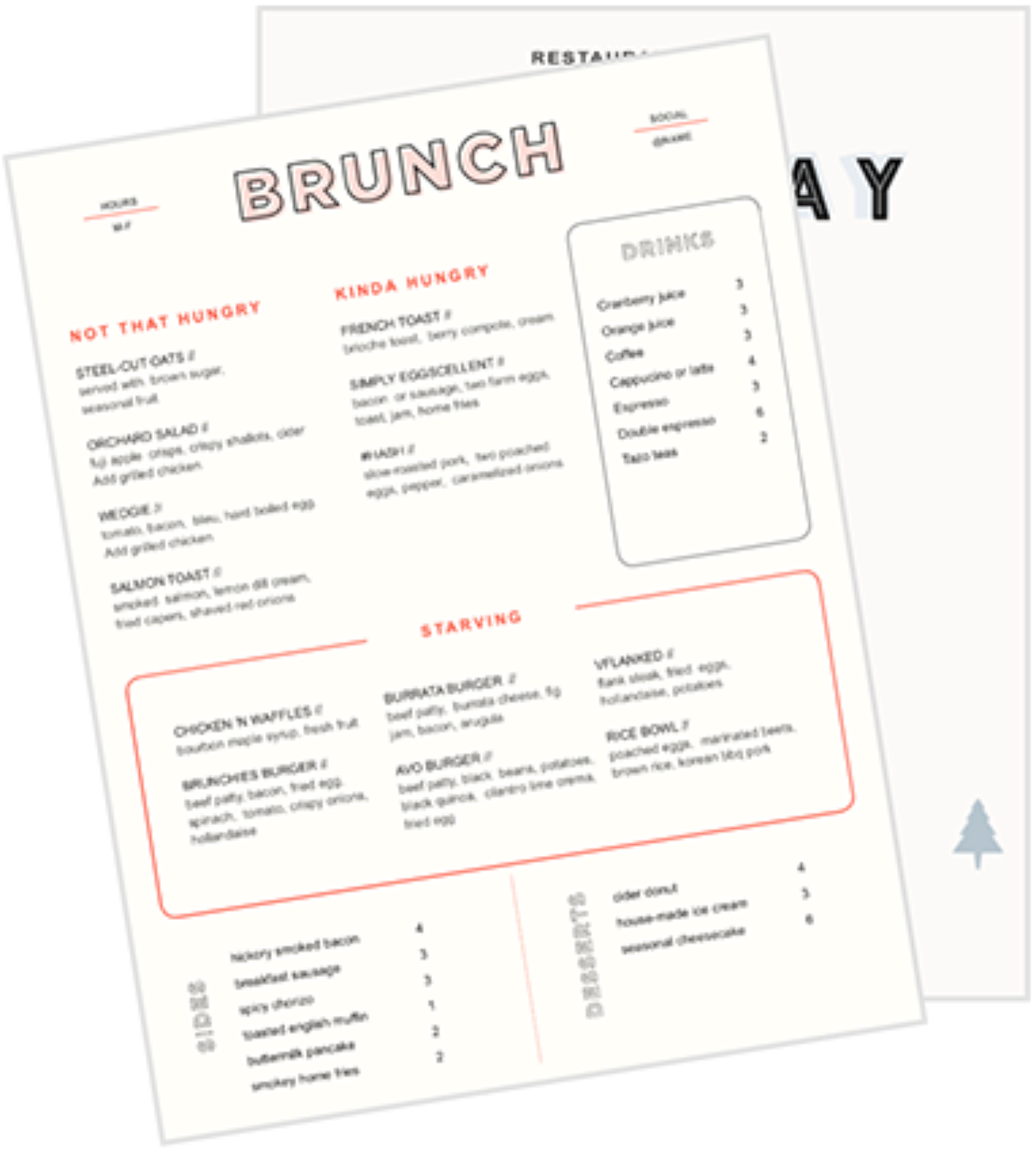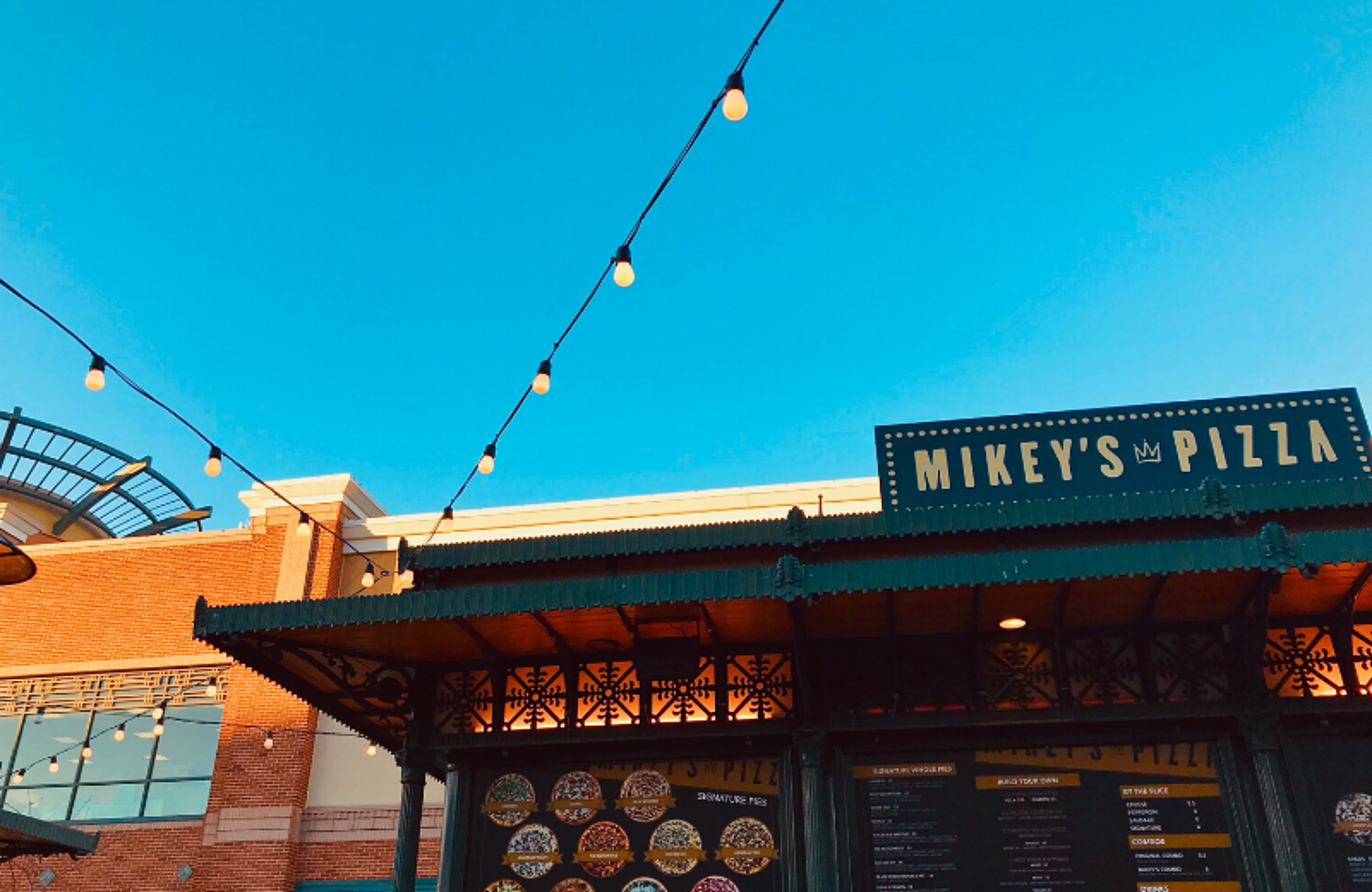
How to Make a Restaurant Menu Design With Examples (Free Template)
Everything you need to know to develop, engineer, and design your perfect restaurant menu.

Tessa ZuluagaAuthor


Restaurant Menu Templates
Use these menu templates as a starting point for your menu design or to give your menus a refresh.
The restaurant menu is one of the core pillars of your guest experience, and it’s your restaurant's most important selling tool. Whether it’s printed, online, or on a menu board above a counter, a well-designed menu can boost your profitability while enhancing the guest experience.
We’re going to get into the 10-step process involved in developing and designing a new or improved menu. For inspiration, check out these free, customizable restaurant menu templates.
How Many Items Should be on a Restaurant Menu?
The short answer is “fewer than you might think”! George A. Miller, a cognitive psychology expert, found that most people can only retain seven pieces of information at a time. That doesn’t mean you should only have seven menu items, but it does mean that you should consider categorizing your menu items and keeping the offerings within each category between three and seven.
Gone are the days of the enormous restaurant menu with dozens of options. For most restaurants, a massive menu can hurt profitability in the form of unused or spoiled inventory.
To learn more about menu psychology, check out this post on the “why” behind the best menu design decisions.
The Power of Good Restaurant Menu Design
Restaurant menu design can make or break your restaurant's profits. If your least profitable item is the most prominent on the menu, your guests will order it time and again, instead of considering other options that are equally delicious but more profitable for your business. If your food is your art, your menu is your canvas. More on arranging your menu items below.
A great menu helps your server upsell, too — by listing out modifiers to menu items, and by making sure to have your side dishes and add-ons listed out where your guests can easily be tempted by them, you create the opportunity for larger check averages.
Finally, you want your brand to be reflected everywhere your guests interact with your restaurant — on social media, on your website, in your physical decor, and on your menu. This creates a cohesive, and most importantly, memorable experience.
The Ultimate Guide to Restaurant Branding
Use this guide to get tips on how to create a restaurant brand that stands out, attracts customers, and drives repeat visits.

How to Make a Restaurant Menu
A restaurant menu is the printed or online list of the food and drinks offered by a restaurant. There are few hard and fast rules when building a menu because every restaurant’s needs will be unique to their concept.
If you can't afford a designer, and want to take a stab at making a menu yourself, just follow this simple 10-step process on how to create a restaurant menu, or start working off of a menu template to get you started.
1. Write Out all Menu Items
Before you dive into design, you have to learn to write a restaurant menu. Using Excel, a Google Sheet, or even pen and paper, list out all of the meals you want to offer. Google Sheets is great for this, because it's easy to cut, copy, and paste different items, and the sheet will save automatically. Click here to use our template. Don't forget to click File > Make a Copy for your own version.
2. Categorize Menu Items
Categorize all the items into apps, entrees, desserts, or any other categories. Then, decide which menu items you want to appear most prominently on the menu; you may want appetizers to appear at the top of your menu, and you may want a particular appetizer to be at the top of the list because it's a star — high profit, high popularity — according to your menu engineering worksheet. Simply move around your menu items until they're in the exact order you want them to appear on the menu.
3. Set Menu Prices
Notice that we haven't added prices to our spreadsheet yet? That's because prices aren’t decided arbitrarily and they warrant a food cost deep-dive. It’s worth taking the time to learn how to price a restaurant menu.
Menu prices - and how you portray them - are the most crucial aspect of the restaurant food menu.
If you're working off of a previous menu, add in your current prices, and then take a step back to analyze them. Put yourself in your customers' shoes. Based on the restaurant sales data in your point of sale system, could you afford to tweak this menu items' price a little bit to make it more appealing?
Conversely, if you’ve recently had to increase prices in order to pay your staff better or pay for benefits, use your menu as an opportunity to explain that — language like “thanks to these small increases in menu prices, we’ve been able to pay for all of our team’s health insurance” works great and helps connect your customers to the realities of the staff they love.
If you're really starting from scratch, you’ll need to figure out how to price your menu in order to bring in the most profit while delighting your guests.
Our menu engineering course can help you learn how to make data-based decisions on how to price your menu based on your inventory prices and food cost percentages. Even established restaurants could benefit from a refresher on how to use data to make these types of decisions.
4. Create Menu Descriptions
Next is the fun part: we haven't touched the "description" column yet in the sheet.
You could hire a copywriter to come up with menu item descriptions, but the best menu descriptions come from the heart — and right from the source. Consult the chef who created the menu items, think about the story behind each and every meal - the inspiration for its creation, the sourcing of its ingredients, the effort it takes to make - and write down a short description of each menu item on your sheet.
Use descriptive and enticing adjectives — like refreshing, crispy, savory, tangy, sour, sweet, crunchy — where possible, but don’t go overboard.
Consider what a new customer would be picturing if they’re reading your menu for the first time. What may seem obvious to you might not be so clear to a newcomer. Think about what questions or clarification a guest may need and add those descriptions to your restaurant menu.
Menu Engineering Worksheet
Use this menu engineering worksheet, complete with intricate menu engineering formulas, to determine areas of strength and weakness in your restaurant's menu.

5. Decide on a Menu Color Scheme
Now that you have all your menu items laid out on the sheet in an order that makes sense, take a little break from staring at cells and start thinking about graphic design. Choose a color scheme for your menu that reflects your restaurant brand. This can be as simple as choosing three colors you might want to see on the menu, or deciding that you want your menu to be black and white to save money on printing.
We could write a whole blog post about how colors affect your restaurant's perception, but for now, here's Chron on the psychology of restaurant colors, and here are a few color resources designers swear by:
Adobe Colour CC - color wheel tool
ColorDot - color palette tool
ColRD - color inspiration
6. Design Your Restaurant Menu
Now comes the hard part: translating all your hard work on that sheet into a menu design. If you're hiring a designer, simply giving them your menu item spreadsheet and color scheme makes their life so much easier.
If not, you can use software like Microsoft Word, Microsoft Powerpoint, or the Adobe Suite, and use these menu templates as a jumping-off point. As you do, keep in mind these menu design best practices:
- A menu has to be easy to digest. As some might say, "Keep it simple, stupid." Your customers will be overwhelmed by a large menu, so try to keep it to one or two pages.
- Remember the golden triangle. Our eyes typically start in the middle of a page, then move to the top right and top left, so consider putting high-margin dishes at the center and upper right corner of your menu.
- Use dollar signs strategically. A study at Cornell found that diners who ordered from a menu without dollar signs ($) spent significantly more than those who ordered from a traditionally priced menu. Consider removing dollar signs from your menu, and don't list menu prices in a single column so it's easy for customers to compare.
For more insights like these, check out our menu engineering course’s section on menu design.
7. Restaurant Menu Photos
Printed menus benefit from white space, and the more photos or icons you add, the more distracted customers are from your actual content: the food, and those awesome descriptions you just wrote.
You may want to include photos of your most profitable menu items, but these photos need to be high quality - and that quality needs to translate to print. You may have to hire a food photographer to take these photos because low-quality photos can be worse than no photos. Work on your food presentation skills first, and then hire a photographer or a friend to take the perfect photo for your menu.
If you choose to hire a photographer you can also use those photos on your social media. Make sure to also include a link to your digital menu in your social media bios so users can check out your menus before stepping foot in your restaurant.
8. Choose Menu Fonts, Spacing, and Composition
You have a color scheme, a general idea of how you want your menu items to be laid out on the page, and possibly a few photos you want to include. Now, it's time to put it all together to create a restaurant menu.
At this point, many restaurateurs hire a menu designer or turn to menu templates to give them a starting point. It can take an hour, a day, or a week to go through different iterations, considering margins, spacing, fonts, and overall composition. You could create a simple menu like Red Feather did or a more complicated menu like Maudie's. Keep iterating, and don't be afraid to ask for help - from friends, family members, designers, and even existing customers - to find the best design element that fits your menu.
Also, don't forget: updating your menu regularly should be easy. If you don't leave space to add or remove menu items over time, especially if your menu changes seasonally, then you may have to start this whole process over again. As many guests - especially the loyal ones that keep coming back - will remember your menu design and where to find their favorite items, you'll want to make sure it's easy to update, so you don't have to overhaul your menu design again and again.
Menu Engineering Course
Take this course to make the most of your menu. Learn about menu psychology and design, managing your menu online, and adapting your menu to increase sales.

9. Select the Final Menu Layout
Come up with a few design choices to share with your business partners and staff, and vote on which you think is best for your restaurant brand. Your stakeholders will want to review the content - exactly how you're describing each menu item - as well as the prices and the cohesiveness of your brand.
Go through the approval process, and select the menu that you're most excited about. You could even argue for the design you think will increase sales based on data from your restaurant point of sale.
10. Proofread and Print Your Menu
Finally, it's time to print your restaurant menu. But first - take a moment to proofread your menu and send it to someone who hasn't been staring at it for the past week. One misplaced comma or small typo could change your guests' perception of the restaurant. Don't skip this step, because if you do, you could waste a lot of money printing menus that will just end up in the trash.
When you're ready to print, you could simply use Staples printing service to print on quality paper for cheap or use one of these restaurant menu printing services:
The cost of printing depends on how many menus you want, but printing approximately 200 8.5" by 11" menus can cost between $150 - $200.
How to Make a Restaurant Menu Online
When building your menu online, you want to ensure that the descriptions are the same as your print menu or even more details, and that you’re working with an online ordering provider that lets you upload photos.
Not only do photos help keep your brand consistent across platforms, but when guests are ordering online, photos help them understand what they’re gonna get — there’s no server to answer their questions, so it’s important to give as much info as possible.
Use your spreadsheet of menu items, create categories on your online ordering platform, and input your menu items one by one.
You can also create an online menu that your guests access through a QR code while seated in your restaurant! This new way of ordering puts your guests in control of their dining experience, and the menus never get taken away so they can keep the orders coming all night.
Keep Learning about Menu Engineering
Now that you’ve got your restaurant menu printed and set up online, the job isn’t done forever! As time goes by and you notice trends in what your customers order, you’ll find that changing up your menu can keep things fresh and keep the revenue flowing. This menu engineering spreadsheet will help you analyze how each of your menu items are performing and will guide your next menu redesign.
Related Menu Ideas
- How to Make a Deli Menu
- How to Make a Dessert Menu
- How to Make a BBQ Menu
- How to Make a Breakfast Menu
- How to Make a Pizzeria Menu
- How to Make a Takeout Menu
- How to Make a Brewery Menu
- How to Make a Wine Bar Menu
- How to Make a Bar Menu
- How to Make a Coffee Shop Menu
- How to Make a Food Truck Menu
- How to Make a Diner Menu
- How to Make a Bakery Menu
- How to Make a Drink Menu
- How to Make a Cocktail Menu
- How to Make a Catering Menu
- How to Make an Ice Cream Shop Menu
- How to Make a Juice Bar Menu
- How to Make a Fine Dining Menu
Restaurant Menu Templates
Use these menu templates as a starting point for your menu design or to give your menus a refresh.

Is this article helpful?
DISCLAIMER: This information is provided for general informational purposes only, and publication does not constitute an endorsement. Toast does not warrant the accuracy or completeness of any information, text, graphics, links, or other items contained within this content. Toast does not guarantee you will achieve any specific results if you follow any advice herein. It may be advisable for you to consult with a professional such as a lawyer, accountant, or business advisor for advice specific to your situation.
Read More
Subscribe to On the Line
Sign up to get industry intel, advice, tools, and honest takes from real people tackling their restaurants’ greatest challenges.



